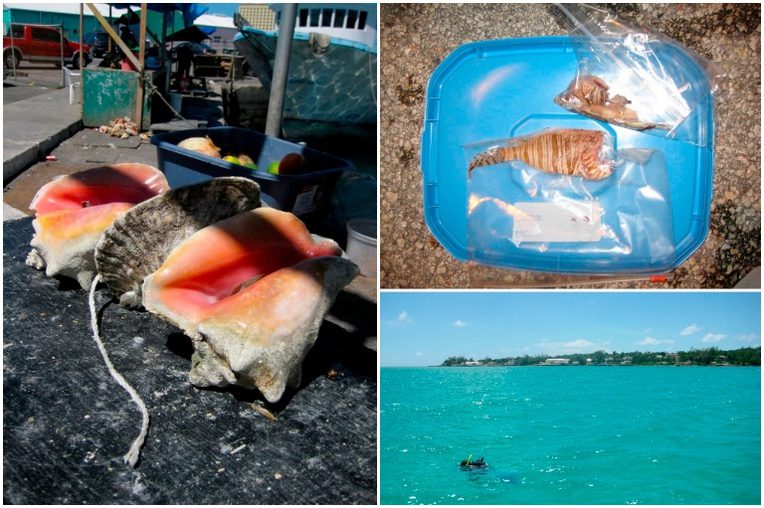This post builds on the research article “The Aquatic Invader: Marine Management Figuring Fishermen, Fisheries, and Lionfish in The Bahamas,” which was published in the November 2012 issue of the Society’s peer-reviewed journal, Cultural Anthropology.

Editorial Overview
In this engaging narrative, Amelia Moore uses the invasive and exotic lionfish as a way to study how marine conservation management frames the relationship between people, natural resources, and fisheries in The Bahamas. Moore argues that the continuous rearticiulations of the relationship between humans and nonhumans results in the naturalization of otherwise unnatural ideas of fish and fishermen. This in turn negatively impacts our greater understanding of fisheries and related events and processes as a whole.
The lionfish has played many roles in Bahamian culture and fisheries - from introduced species, to invasive, to targeted commodity, to "totem" animal. Moore looks at the curious role local fisherman have been inserted into within Bahamian fisheries management. Native commercial fish species in The Bahamas have been overfished, as a result one solution to the invasive lionfish problem has been to target the lionfish as a commercial species and to unleash Bahamian fishermen on them, with the hope that they will overfish the species into submission. Moore gives the reader numerous examples from her own experience of illegal overfishing, including being served marine life out of season and even witnessing the fishing of a protected species. Thus, what could essentially be described as an unnatural process becomes naturalized through discourse. In this vein, Moore looks at the role that social scientists have had in marine fisheries management, in the classifications and discussions surrounding nature and the naturalization of what could be seen as unnatural objects, events, and processes.
Drawing on the work of numerous scholars, such as Haraway, Hayden, and Helmreich, Moore transitions from the more traditional field of marine anthropology and contributes to the emerging fields of multispecies and interspecies ethnography. This emerging field examines the frameworks that position both human and nonhuman others, as these framings are responsible for determining and attributing power. The importance of these positions and framings is emphasized by Moore when she highlights malleability of both fishermen and lionfish in The Bahamas.
Editorial Footnotes
Cultural Anthropology has published a number of related essays on nature and the environment, including Eben Kirksey's The Emergence of Multispecies Ethnography(2010), Jake Kosek's Ecologies of Empire: On the New Uses of the Honeybee (2010), Eva Hayward's Fingereyes's: Impressions of Cup Corals (2010), Agustin Fuentes'sNaturalcultural Encounters in Bali: Monkeys, Temples, Tourists, and Ethnoprimatology(2010), Anand Pandian's Pastoral Power in the Postcolony: On the Biopolitics of the Criminal Animal in South India (2008), David McDermott Hughes' Third Nature: Making Space and Time in the Great Limpopo Conservation Area (2005), and Celia Lowe's Making the Monkey: How the Togean Macaque Went from “New Form” to “Endemic Species” in Indonesians' Conservation Biology (2004).
Additional Readings
Anderies, John M., et al. A Framework to Analyze the Robustness of Social-Ecological Systems from an Institutional Perspective. Ecology and Society 9.1(2004): 1-17.
Bromley, Daniel W. The Crisis in Ocean Governance: Conceptual Confusion, Spurious Economics, Political Indifference. MAST 6.2(2008): 7-22.
Brosius J. Peter, Anna Tsing, and Charles Zerner. Representing Communities: Histories and Politics of Community Based Natural Resource Management. Society and Natural Resources 11 (1998): 157-168.
Haraway, Donna. When Species Meet. Minneapolis: University of Minnesota Press. 2008
Kirksey, Eben. and Stefan Helmreich. The Emergence of Multispecies Ethnography.Cultural Anthropology 25.4 (2010): 545-576.
Marcus, George. Intimate Strangers: The Dynamics of (Non) Relation Between the Natural and Human Sciences. Anthropological Quarterly 75.3 (2002): 519-526.
Questions For Classroom Discussion
1. What does Moore mean when she says that the lionfish and fishermen are malleable?
2. Why are anthropologists and other social scientists increasingly involved in the management of fisheries and other species?
3. In what ways does Moore describe fisheries as dependent on design, not just ecology?
4. What is a 'keystone species' or 'flagstone species'? Can you give any other examples other than the ones described in the article?
5. Can you think of another example of an invasive species? What times of problems, or solutions, have resulted?